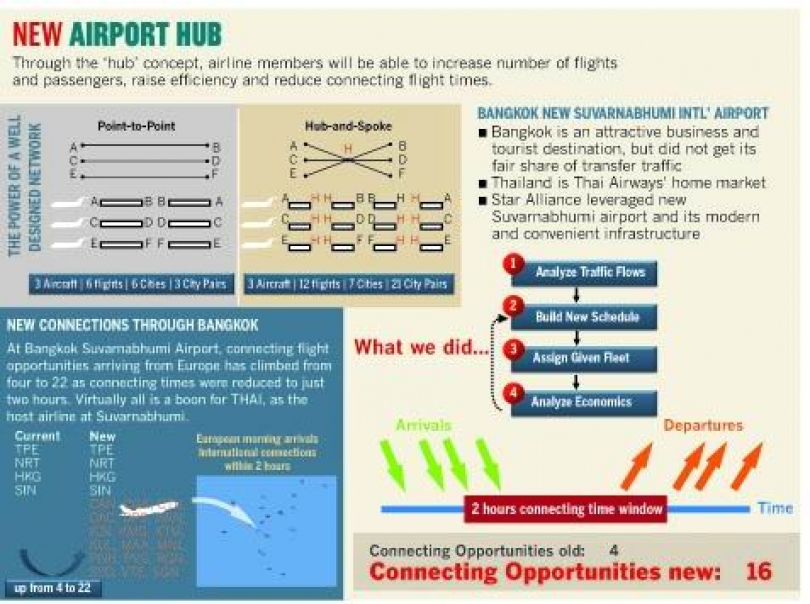Star Alliance: A model for global connectivity

THE global airline alliance model is envied by many other businesses despite the ups and downs in the aviation industry. In fact, Star Alliance is a perfect business school case study for other copycats, Pana Janviroj reports from Frankfurt
CHRISTIAN KLICK waves a booklet that is called “the bible” – containing more than 70 conditions that a group of airlines must follow.
Not quite European Union club rules but something that all airline members quietly accept, as it is a passport to additional revenues from being part of “Star Alliance” from day one.
The veteran vice president of the corporate office at Star Alliance has no second thoughts about what makes a global alliance and connectivity tick.
“It’s the hub that makes it work.”
Star Alliance now operates out of 1,330 airports with 28 member airlines operating to and from 192 countries, 18,500 daily departures, 423,433 employees and 4,709 aircraft.
It was the first alliance of its kind, founded back in 1997.
The alliance system was truly global and alongside the banking industry, airlines have always been heavy users of information technology (IT).
The alliance works on trust, governance and mutual benefits. It doesn’t need members to hold equity, but they have shared the value of efforts and benefits.
As the Greek philosopher Aristotle said, “The whole is greater than the sum of its parts”, or in other words, when individual parts are connected together to form one entity, they are worth more than if the parts were in silos.
Star Alliance – operating with just 60 aviation professionals from 20 countries based in Frankfurt – manages the cross functions of airline members – whether code-sharing, where a long-haul flight feeds passengers to a short or regional flight, or joint use of lounges or terminals.
Its worldwide brand gives instant recognition to air travellers worldwide.
“Often what we do is away from the front end. But our mission is clear – to help with the bottom line of members beyond their own capability,” said Klick, who returned to the “hub” strategy, which is pivotal to the success of the alliance.
“Hub” is what Charamporn Jotikastira, president of Thai Airways International, one of the founding members, highlighted last month when asked how the Thai national carrier will be moving forward.
He didn’t mean an airport expansion, but rather intensifying the hub operations where THAI takes on regional feeder services from incoming Star Alliance members from long-haul flights from Europe, the US and North America, the Middle East and South Asia.
THAI enjoys incremental revenue in the hundreds of millions of dollars annually from being part of Star Alliance
Airline members operating on the “hub” concept can increase flights from, for example, three aircraft from three city pairs point-to-point to 21 city pairs under the alliance.
The number of passengers can double, as witnessed at Japan’s Narita hub.
The drive for efficiency to minimise connecting flight times from code-sharing partners has required Star Alliance to work with airport authorities from the early days of conceptual designs.
For example, at Bangkok’s Suvarnabhumi Airport, connecting flight opportunities arriving from Europe have climbed from four to 22 as connecting times were reduced to just two hours. Virtually everything is a boon for THAI, as the host airline at Suvarnabhumi.
The picture has emerged with lots of planes parked in the morning and leaving by mid-morning rather than “less efficient hubs that will see aircraft coming and going all day”, Klick said.
Admittedly, airports usually like activities to be spread out all day, but it isn’t the game plan for the airlines to optimise revenues, he said.
However, optimising Bangkok as a hub helps with the member airlines’ bottom lines.
The success is witnessed with 33,000 incremental passengers valued at US$17 million (Bt598 million). Optimally, it means achieving two-hour connecting flights.
On a global scale, Star Alliance connecting passengers between member airlines fills about 250 Airbus 320s daily.
The hub strategy has also enabled Star Alliance to build on other seamless services through “moving under one roof” such as joint facilities, superior transfer products and the alliance’s fare products.
The most visible example is Terminal 2 at London’s Heathrow Airport. This not only saw the member carriers, including THAI, sharing a purpose-built new terminal, but also working together in a more integrated manner, both behind the scenes and in customer service |delivery.
The same model is being rolled out in Sao Paulo-Guarulhos and |Los Angeles, and others in the pipeline.
Recently, chief executives of Star Alliance airlines gave the go-ahead for new technology investment and wide-ranging enhancements in operating processes to meet the evolving demands of today’s travellers.
It will invest in multimillion-dollar technology projects, including an advanced IT hub for baggage that is scheduled to go into operation by the end of this year. This new baggage hub is the latest in a series of “plug and play” applications that are supporting member airlines behind the scenes.
Baggage processes are complicated by many different systems and information in operations.
Each airport also runs its own baggage system, making it highly complex to retrieve the current status of bags, locate bags and take effective action if bags are mishandled.
“While mishandling a bag is a relatively rare case in our alliance, despite the fact that we carry almost 1.7 million passengers every day, when things do go wrong it is highly annoying to any customer affected,” Mark Schwab, CEO of Star Alliance, said.
The CEOs also endorsed the development of standardised operating procedures for off-airport/self-service check-in, fast bag-drop technology, baggage self-tagging and automated travel document validation.
These standards will help reduce infrastructure requirements and handling costs at all of the 1,300 airports the alliance is serving.
Pana Janviroj is executive director of Asia News Network. Star Alliance is a partner of ANN.





